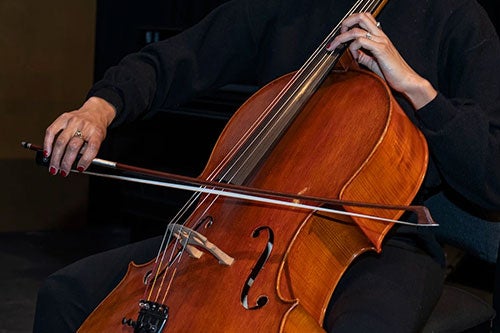
If you haven’t heard of 19th century, German composer Emilie Mayer, you’re probably not alone. While her work was popular in her time, it’s pretty obscure today. That’s about to change.
Music professor Vilde Aaslid became aware of Emilie Mayer’s work while searching for symphonies by female composers for a class. “I’d never heard of her,” said Aaslid. “The students listened to one of her symphonies and absolutely fell head over heels in love with the piece.”
That discovery marked the beginning of a special project, organized by Aaslid and orchestra director Sam Hollister with the help of music students Caleb Hilyard ’23, Megan Rees ’24, and exchange student Chloe Lovell. And thanks to their work, the University’s Symphony Orchestra featured Mayer’s 1850 Overture No. 3 in C major—alongside standards by Mozart and Copland—at its April 22 concert.
The project not only championed underperformed music by a great composer but also created an edition of the piece that other orchestras can access online and perform for free. The project was funded by a grant from the URI Center for the Humanities.
The work of Emilie Mayer
“Much of this unsung music is still either in manuscript form only or, if it has been published, is only available for a steep rental or purchase charge,” said Hollister, who is dedicated to uncovering, performing and creating new editions of works by great composers who often have been ignored. “The mission with projects such as this is to bring a public-domain publication of these pieces into the performance sphere so anyone can download the sheet music and perform it for free.”
Mayer (1812-1883) began serious compositional study relatively late in life but she still was a prolific composer, writing at least seven overtures, numerous chamber works and a staggering eight symphonies. At the time in the 19th century, symphonic composition was a man’s world, Aaslid says.
“With the exception of Louise Farrenc, most women composers of the time—such as Fanny Mendelssohn Hensel and Clara Schumann—didn’t really write symphonies,” she said. “It was thought of as the ultimate masculine genre. But right from the start, Mayer’s orchestral works were celebrated by critics. As a woman who never married and who could support herself with an inheritance, she had some freedoms in her life that allowed her to focus on composition, especially for the orchestra.”
During her life, Mayer’s work was very popular with critics and audiences, but publication was harder to come by. She sent out her manuscripts to conductors to advocate for their performance. “When she died, there was no one left to champion her work,” Aaslid said. “It fell into obscurity pretty soon after she died.”
Bringing her music to life
In the last 20 years, there’s been increased interest in Mayer and her work has started to get published. But the cost of the published editions is prohibitive, Aaslid says. Thankfully, the Berlin State Library holds the bulk of her manuscripts, which are available for download.
That presented a different problem. An 1850s manuscript is not ready for prime time. “You can’t really perform from a manuscript,” said Aaslid. “It’s not practical. It’s hard to read. It’s messy.”
Enter students Hilyard, Rees, and Lovell. Aaslid and Hollister turned to them to take the digitized manuscript of Overture No. 3 in C major and enter it—note by note—into music notation software to produce a score the URI Symphony Orchestra could perform. It’s a painstaking process, Aaslid says, where the students had to enter every single dynamic marking, slur, and articulation.
Hilyard transcribed the first third of the 10-minute overture into the software, which provides a computerized playback. He says the process actually went a little faster than he expected. While he found Mayer’s handwriting neat and detailed, he had to figure out a couple of missing notes and faint pencil marks.
“I was lucky to engrave the first third of the overture,” said music major Hilyard. “It’s great music and like any good Romantic overture, there’s a sense of anticipation for what’s coming next. This really encouraged me to work on it as I couldn’t leave off on a cliffhanger!”
Rees found the process a little more time consuming, including deciphering Mayer’s handwriting and determining her intentions at times. But she says the project is one of the “most amazing things” she’s done. “Multiple times when hearing the overture, I have been brought to tears by how beautiful the music is.”
“Overall my biggest takeaway is that there are so many compositions out there from the Classical and Romantic eras that have not been published or accessible simply because of the composer’s race or gender,” added Rees, a music education major. “This piece is incredibly thought out in terms of form, harmony, and texture between instruments, so it is not a matter of skill as to why these works are not published.”
Lovell, a music composition student from Cardiff University in Wales, says the project has shown her the importance of making female composers’ works available, while also giving her insight into the process.
“As a composition student, I was able to learn more about the writing for a big orchestral work,” said Lovell. “I have only written for small ensembles and although I listen to symphonic works, notating it from the manuscript really helped me to recognize how Emilie Mayer used different ideas and techniques to develop and create this piece.”
Hollister, the orchestra conductor, praised the students for their work on the overture. The orchestra started practicing in early April to prepare for the April 22 concert. “It has been inspiring to hear how quickly the orchestra has picked up on the style and sound of the piece,” Hollister said. “It’s as if it were written for this group specifically. There’s been much to polish but we will get there in no time.”
URI’s finished work on the overture will eventually be uploaded to IMSLP.org, the global hub for public domain sheet music sharing.
—Tony LaRoche

